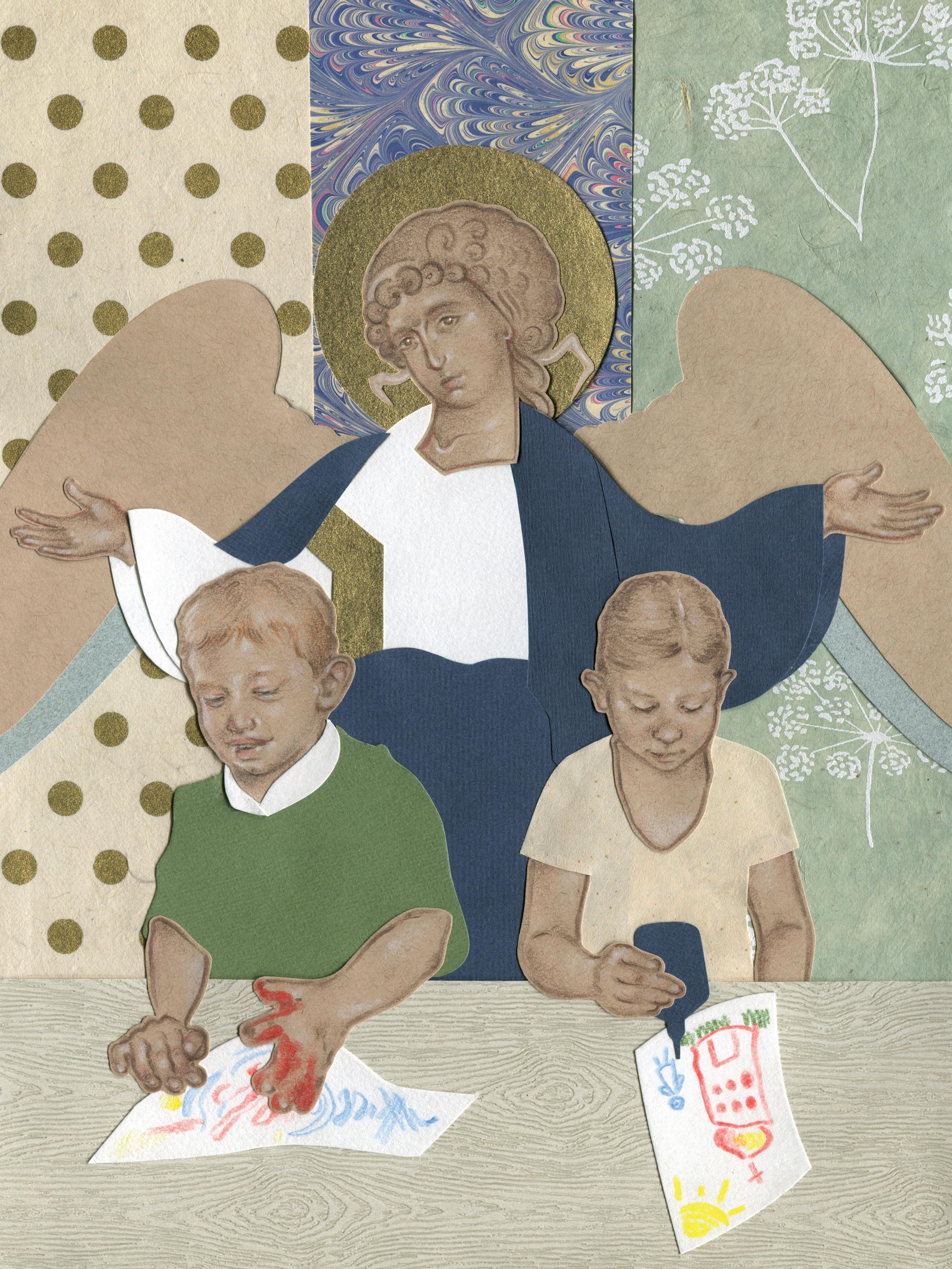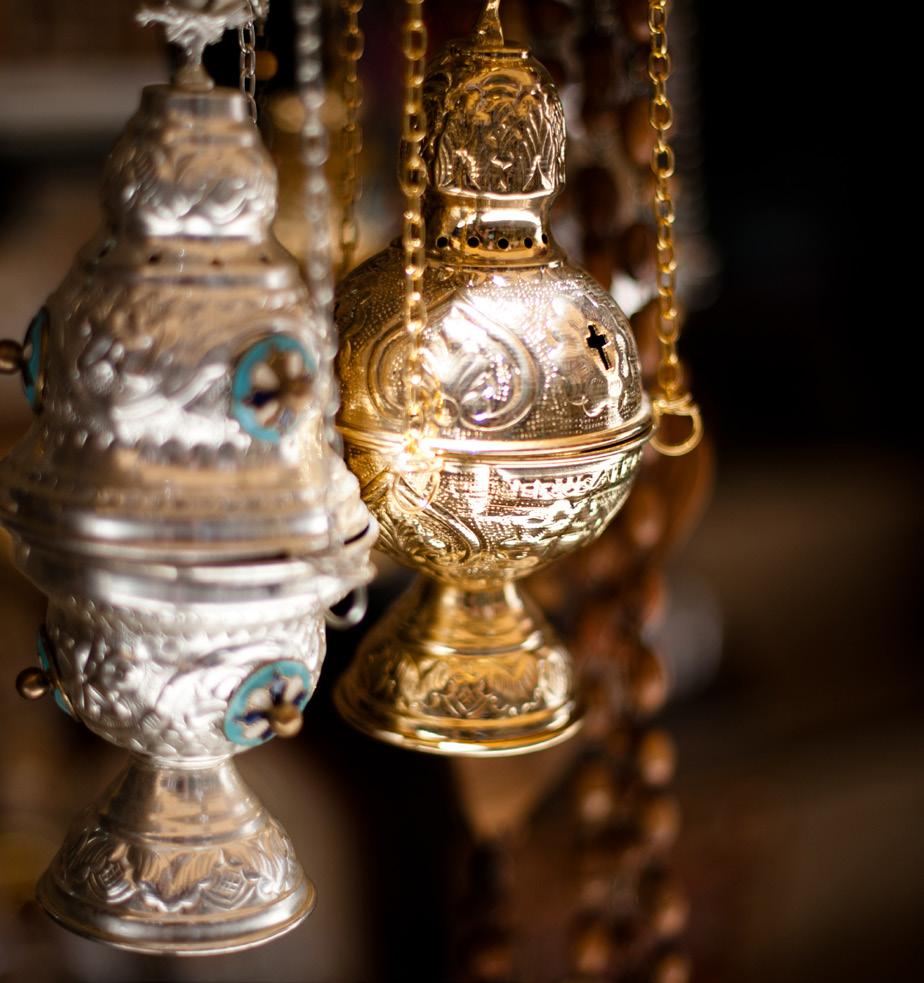
6 minute read
Toward an Immersive Church-School Experience
Toward an Immersive Church-School Experience
by Susan Lukianov
Advertisement
Is your church empty? Sometimes mine is. We know attendance figures are down across most Orthodox jurisdictions in America, and I believe one reason is that our children do not feel engaged— and so parents aren’t coming to services either. Kids often get bored in church; it’s obvious when you see them wandering in and out of the nave or entertaining themselves with books and toys. Even when they are attentive and want to participate, many don’t know how. On top of this, there are constant demands on young families’ time: soccer games, ballet classes, homework assignments, sleepovers, and pool parties. Our parishes have competition and it feels like we lose more than we win.
As a longtime elementary educator, I think the most promising solution is a more robust churchschool experience. Too often, educating our children relies on lectures: a passive format in which adults talk at the kids. Instead, our childrens’ classes should resemble the cycle of services in the Orthodox Church, which are designed to immerse us. Our children deserve learning experiences that excite them and encourage them to ask questions. I propose a model for church school that is engaging, active, tactile, informative, and stimulates growth. If you build it, they will come! During my career of more than 25 years, I have taught elementary students of all grades. I have also taught at the Intrepid Sea, Air & Space Museum in New York City, and I’ve served as a church school teacher and a summer church-camp leader and instructor. I am now the math and science specialist for an elementary school in Connecticut. Following the church’s example of immersive worship, I have developed a series of learning experiences called “Teaching Our Children About Prayer and Faith,” which center on the physical elements of liturgical life: water, incense, church bread, bells, candles, icons, and church buildings. When I teach children about bells, for instance, they learn about the significance of bells in the church. But they also get opportunities to listen to different tolls, ring bells, strike talantons, and make bells of their own. They become actively involved in their own learning, and they learn how to behave toward these elements in the course of it all. I’d like to share some of my experiences, in case others would like to replicate these classes or build upon them. A month of Sundays The lessons I’ve created are easily adaptable for various settings. I’ve delivered them to large multiaged groups (20+ children at once) and to a smaller single-aged group (four students). Most recently, I was asked to facilitate these sessions with a small group of multi-aged, multilingual children (aged 3–10) at Saints Peter and Paul Orthodox Church in Jersey City. Although adaptable, the one non-negotiable element is the length of time required for each session: each one takes at least two hours to allow ample time for the tactile experiences. At Ss. Peter and Paul, we held these one Saturday a month, from 3–5 p.m., followed by Great Vespers. These were held in lieu of the regular Sunday School sessions, but students and parents were asked to share their learning the next day (Sunday) at coffee hour. Many hands make light work Planning and preparation are key. I had to be certain of my content knowledge of the Church and her teachings, as well as how to make each element. I kept in mind the words of Saint John of Kronstadt: “If you teach children—your own or other people’s children—let this work become a service to God; teach with zeal; study beforehand to make your teaching clear, intelligible, as complete as possible, fruitful.” On average, each session required about 5–6 hours of planning/research, and some required an additional hour or two for the physical prep of materials. For example, as part of our study of candles, I researched the history and use of candles in the Orthodox Church, how bees make beeswax, how to harvest it, and how to make beeswax candles. While this program was designed for children, their parents and church-school teachers were invited to attend and volunteer. Something very interesting happened during our first session at Ss. Peter and Paul. In our original plan, I was to work with the children, and Father Joseph Lickwar, the parish priest, was to meet with the parents. After the opening prayer, we went to opposite sides of the hall. Slowly the parent group began to migrate towards my group, and after about 30 minutes we were one large group. The parents were interested in having the same tactile experiences as the children. This was a turning point. We had hooked both children and parents.

Although I was responsible for the majority of the preparation and delivery of instruction, this work can easily be shared among volunteers. For example, one person can prepare the tactile component, another can research the church teachings, and yet another can organize and prepare the videos and other visual aids.
Go the extra mile This series elicited great enthusiasm from children and parents alike. The children were eager to share their knowledge and to take home products, such as bells or incense. Many adults said they had learned things about the Church as well—in fact, they expressed surprise at the amount they learned. But I also know that we all learned from the children. The purity of their hearts, their curiosity, and their ability to see Christ where we do not remind us we need to be more like them.
As Orthodox Christians, we want our children to love God and become adults who are active participants in the Church (tithing and giving freely of time and talents); yet we do not always give them what they need to maintain their unconditional love of God and His Church. If we can provide them with learning experiences that mirror the richness of our services and give them a purpose/role in the church, then they just may choose church!

For additional information about this series or to obtain a digital copy of the lessons, please contact Susan Lukianov at slukianov10@gmail.com. — The following is a brief outline of a session I’ve taught on incense:
Almonroth, License CC-BY-SA-3.0.
◉ Opening Prayer
◉ Transition
◗ Have students move to different areas of the available space. This provides them with a movement break and reinforces that each area has a specific goal/function
◉ Introduction of the church element (water, candles, bells, incense, prosphora)
◗ Explore students’ prior knowledge
◗ Introduce new learning; set goals for the day
◗ Context setting: “Today we are going to make incense. But first, we need to learn the role, significance, and history of incense in the Church.”
◉ Activity 1
◗ Concrete experience: Incense
▲ Provide samples of different types of incense for students to touch and smell
▲ Students share their thoughts and observations
◉ Activity 2
◗ Concrete experience: The censer
◗ Provide at least one censer that students can look at and touch
▲ Explain the structure and symbolism of the parts of the censer
◉ Activity 3
◗ Multimedia and Discussion
▲ Show digital images of frankincense and Boswellia sacra trees
▲ Show video of frankincense sap being harvested and discuss
◉ Activity 4
◗ Concrete experience: Making incense
▲ Guides children through the process of making incense
◉ Wrap-up/Summary of learning (done by students)
Susan Lukianov is the math and science specialist at The Peck Place School in Orange, Connecticut. She is a parishioner at Presentation of Christ into the Temple Orthodox Church in Stratford, Connecticut.










